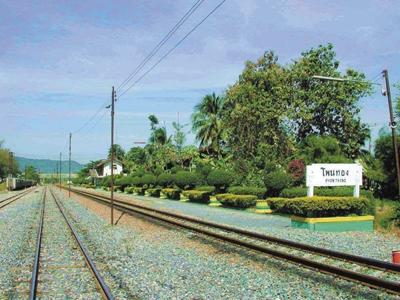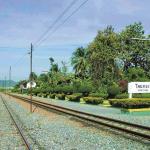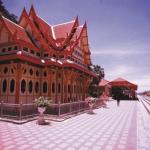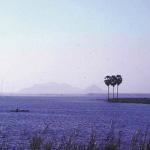Traveling by Train in Thailand
Most people are familiar with the River Kwai Death Railway as being Thailand's scenic rail trip option. However it is really the infamy of the line that escalates this trip in the eyes of the visitor. Admittedly spectacular in parts and with beautiful scenery along the Kwai Noi River to Namtok at the end of the line, it is but a small segment of the SRT system and by no means the only memorable sector to be found.
The River Kwai services leave from Thonburi station with additional services from the main Hualom-phong station during the November festival time. The Thonburi station affords splendid views of the river and is close to the Royal Barge sheds as well as being an architectural wonder with its clock tower facade.
Whether you have an interest in railways or not, trains are still an immensely pleasurable way to view the Thai countryside and are also cheap. The rail fare to Nam Tok, at the end of the Kwai line is still only 60 baht for a one way ticket and the Wongwian Yai service can still be found at around 20 baht round trip.
On local trains and many of the long distance expresses, vendors still ply their wares at the various stops along the line and many will be already aware of the new Korean -manufactured sleeper carriages available on most routes. Sleeper fares are still a real deal and more comfortable than ever and all first class carriages now have a shower area at the end of each carriage.
The Korean rolling stock is but the latest progressive foreign intervention into the State Railway with Japanese Kawasaki train units and British Rail "Sprinter" trains having upgraded the quality of train services within the last 10 years. Of course, the whole system was German-built, being a dream of King Chulalungkorn to link the hinterland to Bangkok and create a united "Thai Land" as well as fortifying links to the weak border points. It has recently celebrated its operational centennial with services duplicating the original public service to Korat.
The climb to the Korat Plateau, after the lineside temple views at Ayutthaya and especially Lopburi, is another of the lesser-noticed scenic sectors of the system. Here the route skirts Khao Yai National Park and the slow ascent affords excellent views of the lush central plains disappearing into the distance to be replaced by the comparatively flat and bare Isaan rice bowl.
For scenic mountain ascents the Doi Khun Tan National Park has by far the best to offer. Most travellers will see it at its best if being an early riser (0600-0700) on the Express Sleeper from Bangkok to Chiangmai.
The morning light hits the deep forested valleys in an array of color that is difficult to find elsewhere in the region and the basically uninhabited area adds to the slow switchback trundle of the train up the mountain. The climax of the ride is the final ascent to Doi Khun Tan station through a 2km tunnel, finally arriving at, in this writer's opinion, the most beautiful, well kept station in the Kingdom. Basketed blossoms on the platform and green peaks in the backdrop give it a special feeling, especially when experienced in the atmosphere of Lanna's cool morning air. The tunnel itself claimed many lives during its construction over a century ago and a plaque in respect of those workers can be seen at the southern portal. Many will argue the point that Hua Hin, with its Royal waiting room, is the more pleasant (and certainly more photographed) station, but Doi Khun Tan, with its inaccessibility, is a credit to the people that created it and those who currently man it. It really is only visited by those hiking into the National Park and for that reason alone has far fewer visitors than the Hua Hin version.
Sprinter train travellers on the Chiangmai day service from Bangkok will see Doi Khun Tan in the evening twilight, which can be almost as rewarding. The Sprinter service has become popular since its introduction, allowing train travellers to see all of the countryside between the two major cities during daylight. A similar situation exists with the Surat Thani to Bangkok sprinter service where travellers are able to view the coastal section from the south in daylight, previously missed with only the overnight sleeper services available. Sprinter trains, with their large viewing windows and airline-style reclining seats are a comfortable and affordable way to view the countryside. There are no traffic jams and one isn't constantly watching for oncoming traffic!
The only criticism of the international express, and indeed all sleeper trains within the kingdom is the fact that first class sleepers have berths situated across the car. As trains tend to rock from side to side, actual sleep is only usually achieved in second class where berths are configured lengthways along side the carriage windows. The result in first class, despite the privacy of a double cabin, is one of being shunted up and down the bed in a traditional railroad manner. Check out the disembarking sleeper passengers when you are at journey's end. The upperclass travellers always seem to have that extra jaded style to their morning arrival.
First class berths on the E & O Express are configured correctly i.e. lengthways and the luxury of this service far surpasses the SRT public trains and perhaps most other services in the world. The train is not a remnant of a bygone age, as are the sister trains in Europe, but a converted version of New Zealand's Silver Streak, Christchurch to Greymouth train of the 1980's. It blends well as a replica, but the minimum $1400 for the one way 2 night trip to and from Singapore is, to most, still expensive. Far easier to experience the train on the frequent Saturday night 5 hour dinner specials from both Bangkok and Singapore at $150 (6,450 baht) per head. Look out in the local press for departure dates.
For those looking for the alternative experience and not requiring E & O luxury, steam excursions ply the local Bangkok routes on the King's Birthday and Chulalungkorn Day as well as during the Kwai festival.
The Ayutthaya specials usually cost around 100 baht for the round trip, a figure unheard of for European rail enthusiasts.
Thai Rail passes still exist but the complications of reserving seats and berths in advance can sometimes outweigh the good value from these visitor's special deals. No matter, as long as one observes the 60 day advance purchase regulation and recognizes the popularity of train travel at holiday times, it is a very rewarding and value for money means of seeing the kingdom. Not only that, the punctuality is what may be expected of an originally German built system, as with the new reliable Skytrain.
* * * * *
 ThingsAsian
ThingsAsian




















